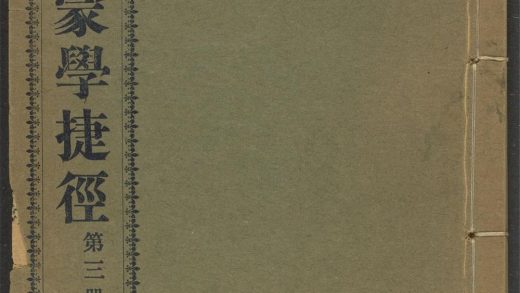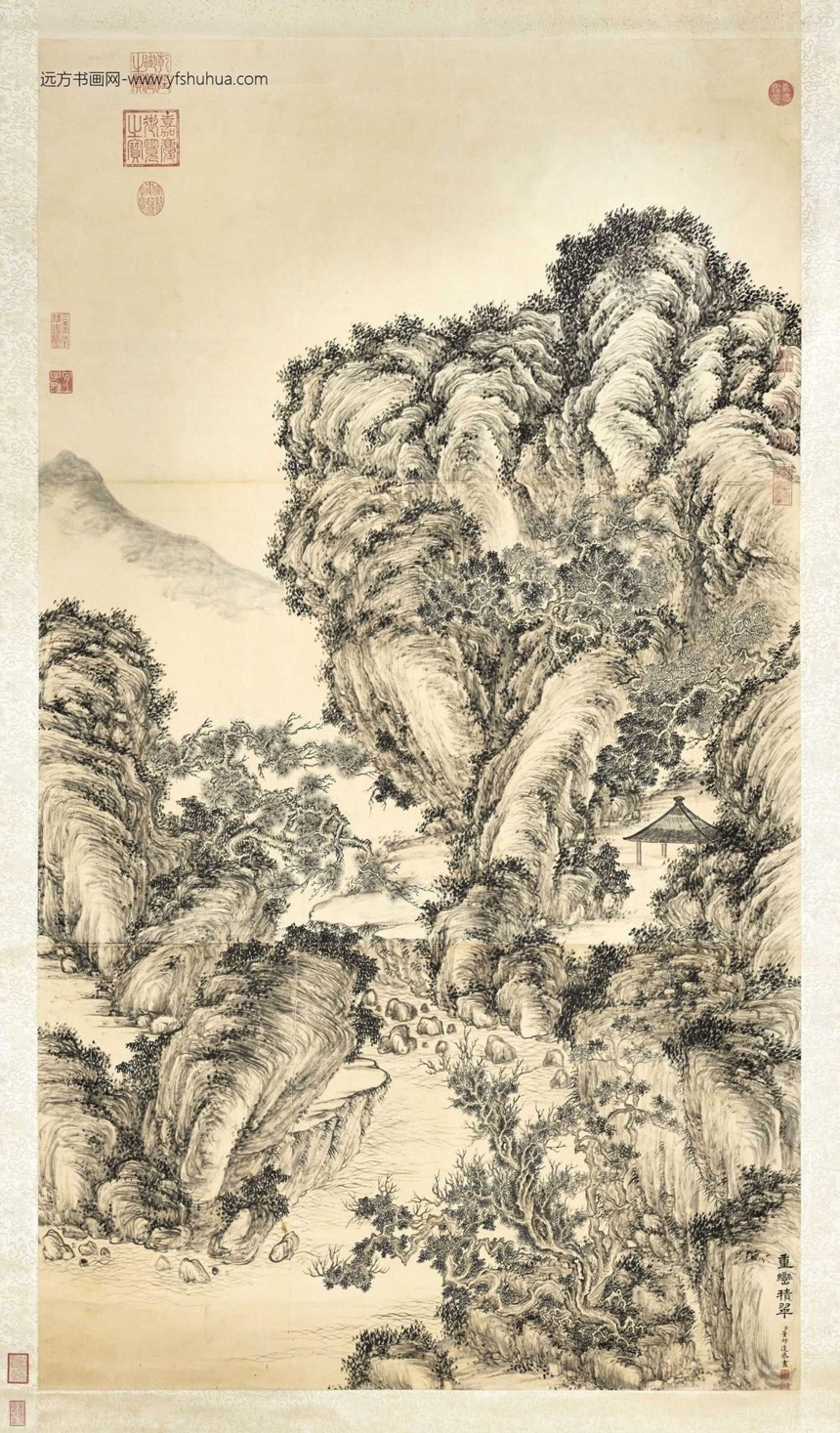【作品基本信息】
| 作者 | 巨然 |
| 品名 | 层岩丛树图轴 |
| 朝代 | 五代南唐 |
| 文件大小 | 18.01MB |
| 分辨率(DPI) | 300×300 |
| 像素大小 | 1412×4252 |
| 尺寸(CM) | 11.95×36.0 |
| 作品数量 | 1 |
| 作品收藏 | 台北故宫博物院 |
| 图片格式 | 默认提供TIF和JPG两个版本 |
基本数据
| 藏品类型 | 绘画 |
| 品名 |
五代南唐巨然层岩丛树图轴 Layered Peaks and Dense Forests |
| 分类 | 绘画 |
| 作者 | 巨然;Juran |
| 数量 | 一轴 |
典藏尺寸
| 【位置】 | 【尺寸】(公分) |
| 本幅 | 144.1×55.4 |
| 诗塘 | 15.2×55.4 |
| 下方 | 12×55.4 |
质地
| 【质地位置】 | 【质地】 |
| 本幅 | 绢 |
| 诗塘 | 绫 |
| 下方 | 绫 |
题跋数据
| 【题跋类别】 | 【作者】 | 【位置】 | 【款识】 | 【书体】 | 【全文】 |
| 题跋 | 清高宗 | 本幅 | 庚寅(公元一七七0年)仲春御题 | 行书 | 回严叠树蔚层层。神与为游韵与胜。何事香光生别议。出蓝偏许仲圭能。庚寅(公元一七七0年)仲春御题。 |
|
印记: 得佳趣、几暇怡情 |
|||||
| 题跋 | 董其昌 | 诗塘 | 其昌 | 行书 | 僧巨然真迹神品。观此图。始知吴仲圭师承有出蓝之能。元四大家之自本自根。非易易也。其昌。 |
| 题跋 | 王铎 | 下方 | 崇祯皇帝十六年 | 行书 | 层岩生动。竟移参泉日华诸峰于此。明日别浒墅。心犹游其中。王铎题为石𡪾亲契。癸未三月夜。同观者吾诸弟与朱五溪。时雨新来未滂。吾占验诸占否否。崇祯皇帝十六年。 |
|
印记: 西雒王铎 |
|||||
| 题签 | 清高宗 | 行书 | 巨然层岩丛树真迹神品。 | ||
|
印记: 乾隆宸翰 |
|||||
印记资料
| 【印记类别】 | 【印记】 |
| 鉴藏宝玺 | 乾隆御览之宝 |
| 鉴藏宝玺 | 乾隆鉴赏 |
| 鉴藏宝玺 | 石渠宝笈 |
| 鉴藏宝玺 | 三希堂精鉴玺 |
| 鉴藏宝玺 | 宜子孙 |
| 鉴藏宝玺 | 养心殿鉴藏宝 |
| 鉴藏宝玺 | 石渠继鉴 |
| 鉴藏宝玺 | 嘉庆御览之宝 |
| 鉴藏宝玺 | 宣统御览之宝 |
| 鉴藏宝玺 | 宣统鉴赏 |
| 鉴藏宝玺 | 无逸斋精鉴玺 |
| 收传印记 | 宣和殿宝 |
| 收传印记 | 司印(半印) |
| 收传印记 | 尚书省印 |
主题
| 【主题类别】 | 【主题(第一层)】 | 【主题(第二层)】 | 【主题说明】 |
| 主要主题 | 山水 | ||
| 其他主题 | 树木 |
技法
| 【技法】 | 【技法细目】 |
| 皴法 | 披麻皴 |
参考数据
| 【类别】 | 【参考数据】 |
| 收藏着录 | 石渠宝笈初编(养心殿),上册,页642 |
| 收藏着录 | 故宫书画录(卷五),第三册,页26 |
| 收藏着录 | 故宫书画图录,第一册,页99-100 |
| 参考书目 |
1.林柏亭,〈五代南唐巨然层岩丛树图〉,收入王耀庭、许郭璜、陈阶晋编,《故宫书画菁华特辑》(台北:国立故宫博物院,1987年初版,2001年再版),页62-63。 2.陈韵如,〈五代南唐巨然层岩丛树图轴〉,收入林柏亭主编,《大观-北宋书画特展》(台北:国立故宫博物院,2006年初版一刷),页50-53。 3.〈五代南唐巨然层岩丛树〉,收入国立故宫博物院编辑委员会编,《山水画墨法特展图录》(台北:国立故宫博物院,1987年七月初版),页59。 4.林柏亭,〈五代南唐巨然层岩丛树〉,《故宫文物月刊》,第200期(1999年11月),页24-25。 5.傅申,〈巨然存世画迹之比较研究〉,《故宫季刊》,第二卷第二期(1967年十月),51-79。 6.彭慧萍,〈两宋”尚书省印”之研究回顾暨五项商榷〉,《故宫博物院院刊》,第141期(2009年第1期),页44-59。 7.林莉娜,〈五代南唐巨然层岩丛树图〉,收入蔡玫芬主编,《精彩一百 国宝总动员》(台北:国立故宫博物院,2011年九月初版一刷),页250。 |
| 内容简介(中文) | 巨然(活动于公元十世纪后期),江宁(今南京)人。开元寺僧,擅写江南景色,师法董源,亡国后,随李后主至北宋汴京。因巨然曾接受北方画坛的影响,故而一变董源横向发展的「平远」山水而为立轴形式的「高远」山水,但是用以描绘山峦的「披麻皴」与山顶山石的「矾头」,仍是董巨派的特征。另外,画中使用淡墨,用以捕捉一抹云岚的氛围,让人想起烟雨江南,则不改其南方山水画派的本质。 |
| 内容简介(英文) | Chu-jan, a native of Chiang-ning (modern Nanking), was a monk at the K’ai-yuan Temple who painted Kiangnan scenery. A student of Tung Yuan, after the fall of the Southern T’ang, he followed the vanquished Li Hou-chu to the Sung capital K’ai-feng. Since Chu-jan came under the influence of the northern landscape style, his horizontal “level-distance” manner of Tung Yuan was adapted to become a vertical “high distance” one. Yet he still retained the Tung style of “alum heads” for mountaintops and “hemp-fiber strokes” to texture the hills. He also continued to use light ink to capture the atmosphere of cloudy hills to suggest Kiangnan shrouded in mist and rain, thus retaining aspects of the southern landscape tradition. |
| 内容简介(中文) | 本幅山水自十七世纪以来即为评家指为巨然之代表作品。但此是否巨然亲笔,因为款识资料,近代学者尚无定论。最近本院在画面右上方发现「尚书省印」,该印出自十二世纪初,为本作之时代下限提供了新的参考。 与一般所见北宋山水画不同,本作缺乏中、远景的区隔,只对弥漫着烟岚的山中景致作近距离的描写。北宋时存在着一种多轴连屏的形式,或许此轴正是某套成组山水的部份。(20061206) |
| 内容简介(英文) | Since the 17th century, this landscape painting has been regarded by connoisseurs as a representative work of Chu-jan. However, whether it was actually done by him, based on information in the inscription, has yet to be decided among modern scholars. Nevertheless, researchers working at the National Palace Museum have recently discovered a seal in the upper right part of the painting that reads, “Shang-shu sheng yin” (Seal of the Department of State Affairs). This official seal was used in the early 12th century, offering new evidence extending the date of the work back to at least this period. As opposed to features commonly seen in Northern Sung landscape paintings, this work lacks a clear distinction between the middle- and background, instead only depicting a short distance of the peaks pervaded by mist in the middleground scenery. In the Northern Sung there appeared a kind of multiple hanging scroll screen landscape presentation, and perhaps this work was originally part of such a set of such paintings in this formula.(20061206) |
| 内容简介(中文) |
巨然(活动于10世纪后半),钟陵(今南京)人。南唐灭亡,随李后主降宋至汴京。工画山水,师事董源,与师齐名,并称董巨。 此轴表现江南林木挺劲、烟岚缭绕的气象,景物虚实变化巧妙。描绘松软土石的披麻皴与山头卵石的矾头,皆为「董巨画派」典型特征。「之」字形路径蜿蜒萦回深入山中,增添了画面的纵深感。诗塘上方明代董其昌将此图定为「僧巨然真迹神品」。 (20110913) |
| 内容简介(英文) |
Juran was a native of Zhongling (modern Nanjing). After the Southern Tang was vanquished, he followed its ruler, Li Houzhu, in surrendering to the Song and going to its capital of Bianjing. Juran excelled at painting landscapes, studying with Dong Yuan and achieving fame equal to his teacher, hence becoming known together as “Dong-Ju.” This painting exhibits the powerful forests of Jiangnan and its atmosphere of swirling mists and fog, the solid and void areas in the scenery are varied with marvelous effects. The rendering of “hemp-fiber” texturing for the soft earth and “alum heads” for the round rocks of the mountaintops are typical features of the “Dong-Ju Painting School.” A zigzagging path also meanders deep into the mountains, adding to a sense of depth in the painting. Dong Qichang in the mounted inscription on this painting wrote, “Authentic work in the ‘Spirited’ category by the monk Juran.” (20110913) |
| 网页展示说明 |
巨然(公元10世纪后半叶),南唐钟陵人,开元寺的和尚。南唐被宋灭亡(公元975年)后,巨然随李后主降宋,而迁至汴梁。擅画山水,画法学自董源。继承其师之披麻皴(如麻布纤维散开来一般的笔触表现)而自创山峦阴郁层迭情景之画格,被称赞为造化之神。 此幅画山径曲折萦回,穿过树林深入山中。除林麓间、峰峦上有俗称「卵石」或「矾头」之群石之外,山石多以披麻皴法细腻描绘,笔笔沉着而带润泽之意。山间由下到上配以苍郁的树林,巧妙地表现出深山沈潜的景观。如董其昌「巨然真迹神品」题识所示,堪称巨然画中绝佳珍品。 (20110913) |
| 参考书目 | 〈五代南唐巨然层岩丛树图轴〉,收入李玉珉、何炎泉、邱士华主编《妙合神离-董其昌书画特展》(台北:国立故宫博物院,2016.01),页258-261、397。 |
| 参考书目 | 国立故宫博物院编辑委员会,〈五代南唐巨然层岩丛树图轴〉,收入《故宫书画菁华特辑》(台北:国立故宫博物院,1996.10),页62-63。 |
| 参考书目 | 林丽江,〈五代南唐巨然层岩丛树图轴〉,收入林丽江、何炎泉主编《写尽繁华-晚明文化人王世贞与他的志业》(台北:国立故宫博物院,2022.10),页96-97。 |
【作品展示】

五代南唐巨然层岩丛树图轴




